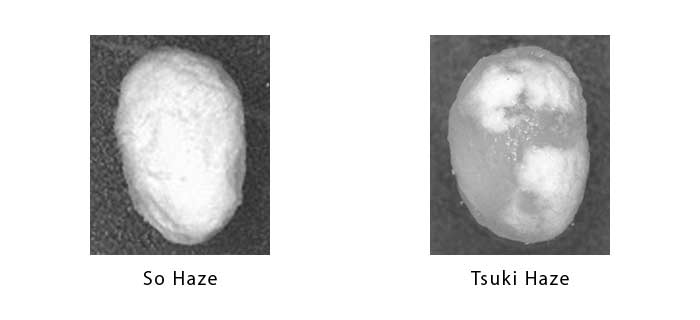Haze
- 【English】
- Growth state of koji-kin
- 【Japanese】
- 破精(はぜ)
A term expressing the form of propagation of koji -kin. The spores of koji sprinkled on steamed rice germinate and grow. When the hyphae become visible as white spots, this is called haze (pronounced like blasé (but with a short “a” sound as in “hat”), not to rhyme with the English word “blaze”). The extent to which this spreads across the grain is called haze-mawari (破精廻り), and the degree to which the hyphae grow into the centre of the grains as haze-komi (破精込み). The degree and condition of haze are key indicators for the handling of sei-kiku and suitability of koji quality.
The phenomenon where the growth of the hyphae is insufficient, and the steamed rice simply seems to get harder, is known as haze-ochi (破精落ち), meaning roughly “missed haze”. The type of koji where the haze is over the surface of the grain but has only grown shallowly inwards is called nuri-haze (ぬり破精, roughly, “painted haze”). This occurs when the steamed or white rice has a hard centre but a high moisture content on the surface, and enzyme activity is low. On the other hand, the kind of koji where growth is deep in an inwards direction as well as across the surface of the grain is called so-haze (総破精, long “o”, “overall haze”). This kind is common in cases where the rice has been steamed to a suitable hardness of texture. With its high levels of enzyme activity, it makes ideal shubo-koji.
Tsuki-haze (also known as tiger- or speckled haze) sees the haze on the surface of the grain in spots. Though there are areas of the grain surface without any growth, the haze grows inward towards the centre of the grain. It is usually young koji with a good aroma, and its level of enzyme activity makes it suitable for use as kake-koji.
If the koji hyphae grow into the centre of the grain, and the starch of the kernel is decomposed by enzymes, becoming soft to the point where the grain can easily be squashed between the fingers, it is called baka-haze. Enzyme activity in fact ends up lower, and such koji is not good for brewing as it tends to give heavy flavours.


